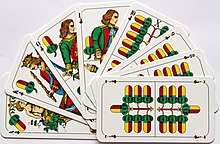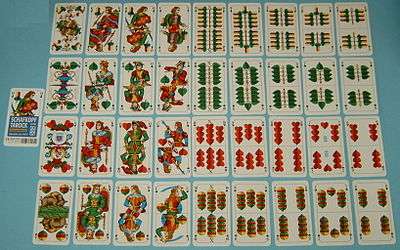Wallachen
Wallachen or Walachen is an Old Bavarian card game which used to be very popular in eastern Bavaria.[1] Although, by 2012, it had become a rarer sight at pub tables, there have been more recent moves to revive it. Wallachen is a relatively simple three-hander that is easy to learn.[2] As a result, like Grasobern, it has a relatively relaxed character without the mental demands of Schafkopf or the psychological stress of Watten.[3]
 The suit of Acorns from a Bavarian pack | |
| Origin | Bavaria |
|---|---|
| Type | Plain-trick game |
| Players | 3 |
| Cards | 32 |
| Deck | German |
| Play | Clockwise |
| Card rank (highest first) | A K O U 10 9 8 7 |
| Related games | |
| Preferans, Préférence, Bavarian Tarock, Bolachen | |
Background
Wallachen appears to have originally come from the Bohemian area. It goes under various other names depending on the region, for example in the area of Grafenau it is also called Säbeln. Other spelling variants include Walachen or Wallachern.[1] According to Rohrmayer in 2015, after Schafkopf and Watten, Wallachen is probably still the most widely played card game in Old Bavaria (especially East Bavaria) and therefore an indispensable part of Bavarian pub culture.[4]
Cards

Like Schafkopf, Wallachen is played with German playing cards of the Bavarian pattern. These are usually marketed as Tarock/Schafkopf packs of 36 cards. The Sixes are removed as in Schafkopf and Grasobern.[1]
| Suits of the German pack | |||
| Bells (Schellen) | Hearts (Herz) | Leaves (Gras) | Acorns (Eichel) |
Aim
The aim is to win six or more tricks out of a total of ten. Players usually play for small sums of money, but they may also keep score by using counters or recording points.[1]
Card ranking
Trick-taking power
For trick-taking the cards rank as follows (from highest to lowest): Sow (Sau) (Deuce, marked "A") > King > Ober > Unter > 10 > 9 > 8 > 7.
| Card values within the four suits | |||
| Acorns | Leaves | Hearts | Bells |
Trumps
In the normal game, the card led to the first trick determines the trump suit for the hand. Within the trump suit cards rank as shown above and all trumps outrank other suit cards. There are no trumps in Bettel and Mord.[1]
Playing
Dealing
Dealer shuffles the pack, offers it to middlehand to cut and then deals ten cards each, either in two packets of 5 or in two packets of 4 and one of 2 or in three packets of 3, 4 and 3 cards respectively. Two cards are then dealt to a start. Each player has a doubling token such as a coin or matchbox in front of them. After the first 3 cards have been dealt to each player, the deal is paused while players look at these cards, and any player may 'double' (doppeln) the stake by pushing their token forwards. For example if all three players do this the stake is multiplied by 8 for this deal.[1][5]
Auction
The player to the left of the dealer, forehand, begins the auction by announcing whether to will "play" (ich spiele) or "pass" (weiter). If forehand plays and the other two players agree and forehand does not raise the bid, forehand becomes the declarer and has to take six tricks to win. If, however, the next player in clockwise order, middlehand, also wants to play, he has to outbid forehand by announcing "Seven" (Sieben), which commits him to taking at least seven tricks. Forehand may respond by equalling middlehand's bid with "me too" or "hold" (Selber or ich halte). Forehand and middlehand continue to bid until one gives up by saying "pass". Next, the dealer has the opportunity to outbid the highest bid so far. The highest bidder becomes the declarer and plays against the other two 'defenders'.[1]
Once the bidding reaches the point where two players both bid ten tricks, the next highest bid is a Bettel. Bettel in turn can be outbid by Mord, the highest contract.[1]
Once the declarer (or soloist) has been determined, he may pick up the two cards from the start, choose the most favourable hand and discard two cards, face down, back to the start. The start plays no further part in the game.[1]
It is possible that the two cards from the start change the soloist's tactics or even undermine them. On the one hand, he may decide to stick with the number of tricks he first announced. On the other hand, he may increase the number of tricks bid, or change his contract to Bettel or Mord (the latter is called Kini in some regions). In Bettel, the player must not take a single trick, in Mord he must take all of them. So Bettel corresponds to Bettel in Schafkopf or to Null in Skat; Mord corresponds to the Tout from Schafkopf.[1]
- Bid summary
From lowest to highest the possible bids are: Six, Seven, Eight, Nine, Bettel, Mord.[6]
Raising the game value
Before the end of the first round, players may raise the game value by announcing Kontra or Re. Each Kontra or Re doubles the stakes. For Bettel and Mord there is a higher pre-agreed tariff.[1]
Playing
Once the declarer has decided whether to play the announced game or switch to Bettel or Mord, he discards two unwanted cards to the start and leads to the first trick. The soloist always leads, regardless of his position with respect to the dealer. The led card determines the trump suit. The two defenders must play a trump if they have one. Generally Farbzwang applies, i.e. the led suit must be followed. In addition, players must try to win the trick if possible, either with a trump or with a suit card; this is called Stichzwang. Whoever wins the trick leads to the next trick. Players may ask to see the last trick taken by their opponent(s).[1]
In some places, the defenders may indicate a blank card by tapping clearly audibly on the table when discarding the only or last remaining card of a suit.[7]
Scoring
After all the cards have been played, the tricks are counted. The soloist must take at least as many tricks as announced in order to win. If he wins, he receives the pre-agreed stake from each of the defenders for each trick taken. If the soloist loses, he has to pay the stake for the announced number of tricks to each defender. The game score is calculated as follows: payment = the agreed stake per trick x number of tricks. This game value may, however, be doubled before the game starts through the announcements of "Kontra" and "Re" and/or the Doppeln.[1]
If no player wants to 'play', forehand becomes the soloist. Alternatively, each player may pay an additional stake into the 'pot' for the winner of the next game.[1]
Strategy
The difficulty in Wallachen is in accurately estimating the number of tricks that one can take and then bidding correctly. In addition, the soloist must discard the right cards after picking up the start.[1]
Similarities
Wallachen is quite similar to Austrian Préférence, indeed Geiser states that Préférence is called Walàcheln or Walàchen in Bavaria.[8] However, a major difference appears to be that there is no suit hierarchy in Wallachen. By contrast, Bavarian Tarock is superficially similar with respect to the dealing of cards and the auction, but is a point-trick game, not a plain-trick game.
See also
- Bolachen - a simpler version of Wallachen.
References
- Wallachen: Niederbayern und Oberpfälzer lieben Wallachen at www.br.de. Retrieved 25 August 2018
- Sirch 2008, p. 61.
- Bayerische Kartenspiele: Vom Aussterben bedroht: Retten Sie das Karteln! at www.abendzeitung-muenchen.de. Retrieved 25 August 2018
- Rohrmayer 2015, p. 2.
- Rohrmayer 2015, p. 76.
- Rohrmayer 2015, p. 31.
- Rohrmayer 2015, p. 33.
- Geiser 2004, p. 37.
Literature
- Rohrmayer, Erich (2015). Lerne Wallachen: Eine Spielanleitung für Anfänger, 1st edition. Amberg, Buch & Kunstverlag Oberpfalz. ISBN 9 783955 870232
- Sirch, Walter (2008). Vom Alten zum Zwanzger - Bayerische Kartenspiele für Kinder und Erwachsene - neu entdeckt. Bayerischer Trachtenverband.